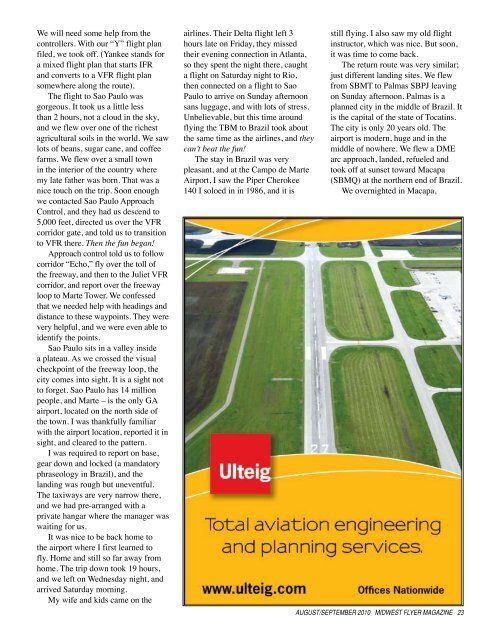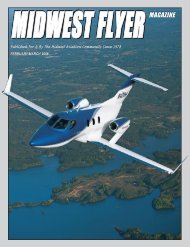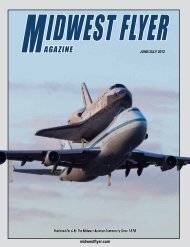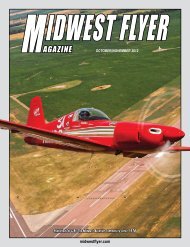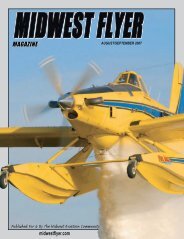AGAZINE - Midwest Flyer
AGAZINE - Midwest Flyer
AGAZINE - Midwest Flyer
Create successful ePaper yourself
Turn your PDF publications into a flip-book with our unique Google optimized e-Paper software.
We will need some help from the<br />
controllers. With our “Y” flight plan<br />
filed, we took off. (Yankee stands for<br />
a mixed flight plan that starts IFR<br />
and converts to a VFR flight plan<br />
somewhere along the route).<br />
The flight to Sao Paulo was<br />
gorgeous. It took us a little less<br />
than 2 hours, not a cloud in the sky,<br />
and we flew over one of the richest<br />
agricultural soils in the world. We saw<br />
lots of beans, sugar cane, and coffee<br />
farms. We flew over a small town<br />
in the interior of the country where<br />
my late father was born. That was a<br />
nice touch on the trip. Soon enough<br />
we contacted Sao Paulo Approach<br />
Control, and they had us descend to<br />
5,000 feet, directed us over the VFR<br />
corridor gate, and told us to transition<br />
to VFR there. Then the fun began!<br />
Approach control told us to follow<br />
corridor “Echo,” fly over the toll of<br />
the freeway, and then to the Juliet VFR<br />
corridor, and report over the freeway<br />
loop to Marte Tower. We confessed<br />
that we needed help with headings and<br />
distance to these waypoints. They were<br />
very helpful, and we were even able to<br />
identify the points.<br />
Sao Paulo sits in a valley inside<br />
a plateau. As we crossed the visual<br />
checkpoint of the freeway loop, the<br />
city comes into sight. It is a sight not<br />
to forget. Sao Paulo has 14 million<br />
people, and Marte – is the only GA<br />
airport, located on the north side of<br />
the town. I was thankfully familiar<br />
with the airport location, reported it in<br />
sight, and cleared to the pattern.<br />
I was required to report on base,<br />
gear down and locked (a mandatory<br />
phraseology in Brazil), and the<br />
landing was rough but uneventful.<br />
The taxiways are very narrow there,<br />
and we had pre-arranged with a<br />
private hangar where the manager was<br />
waiting for us.<br />
It was nice to be back home to<br />
the airport where I first learned to<br />
fly. Home and still so far away from<br />
home. The trip down took 19 hours,<br />
and we left on Wednesday night, and<br />
arrived Saturday morning.<br />
My wife and kids came on the<br />
airlines. Their Delta flight left 3<br />
hours late on Friday, they missed<br />
their evening connection in Atlanta,<br />
so they spent the night there, caught<br />
a flight on Saturday night to Rio,<br />
then connected on a flight to Sao<br />
Paulo to arrive on Sunday afternoon<br />
sans luggage, and with lots of stress.<br />
Unbelievable, but this time around<br />
flying the TBM to Brazil took about<br />
the same time as the airlines, and they<br />
can’t beat the fun!<br />
The stay in Brazil was very<br />
pleasant, and at the Campo de Marte<br />
Airport, I saw the Piper Cherokee<br />
140 I soloed in in 1986, and it is<br />
still flying. I also saw my old flight<br />
instructor, which was nice. But soon,<br />
it was time to come back.<br />
The return route was very similar;<br />
just different landing sites. We flew<br />
from SBMT to Palmas SBPJ leaving<br />
on Sunday afternoon. Palmas is a<br />
planned city in the middle of Brazil. It<br />
is the capital of the state of Tocatins.<br />
The city is only 20 years old. The<br />
airport is modern, huge and in the<br />
middle of nowhere. We flew a DME<br />
arc approach, landed, refueled and<br />
took off at sunset toward Macapa<br />
(SBMQ) at the northern end of Brazil.<br />
We overnighted in Macapa,<br />
AUGUST/SEPTEMBER 2010 MIDWEST FLYER M<strong>AGAZINE</strong> 23


